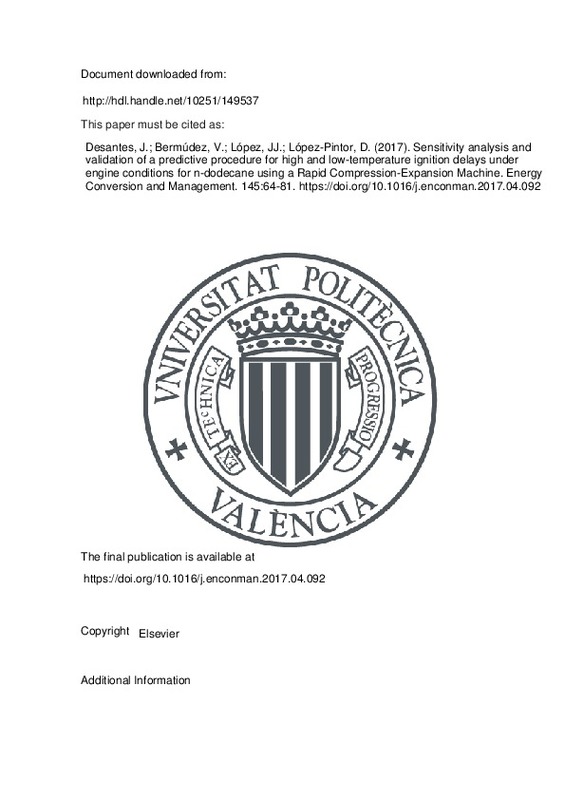JavaScript is disabled for your browser. Some features of this site may not work without it.
Buscar en RiuNet
Listar
Mi cuenta
Estadísticas
Ayuda RiuNet
Admin. UPV
Sensitivity analysis and validation of a predictive procedure for high and low-temperature ignition delays under engine conditions for n-dodecane using a Rapid Compression-Expansion Machine
Mostrar el registro sencillo del ítem
Ficheros en el ítem
| dc.contributor.author | Desantes, J.M.
|
es_ES |
| dc.contributor.author | Bermúdez, Vicente
|
es_ES |
| dc.contributor.author | López, J. Javier
|
es_ES |
| dc.contributor.author | López-Pintor, Darío
|
es_ES |
| dc.date.accessioned | 2020-09-08T03:31:51Z | |
| dc.date.available | 2020-09-08T03:31:51Z | |
| dc.date.issued | 2017-08-01 | es_ES |
| dc.identifier.issn | 0196-8904 | es_ES |
| dc.identifier.uri | http://hdl.handle.net/10251/149537 | |
| dc.description.abstract | [EN] A predictive procedure for cool flames and high-temperature ignition delays based on the accumulation and consumption of chain carriers has been validated for n-dodecane under engine conditions. To do so, an experimental parametric study has been carried out in a Rapid Compression-Expansion Machine, measuring the ignition times for different compression ratios (14 and 19), initial temperatures (from 403 K to 463 K), O-2 molar fractions (from 0.21 to 0.16) and equivalence ratios (from 0.4 to 0.7). The measured ignition delays have been compared to results from chemical kinetic simulations performed in CHEMKIN using a 0-D reactor that replicates the experimental conditions by solving five different chemical kinetic mechanisms, as a way to evaluate the mechanisms accuracy and variability. In general, all chemical kinetic mechanisms are able to accurately replicate the experimental ignition delays, being the mean relative deviation lower than 1.9% and 1.6% for both ignition stages, cool flames and the high-temperature ignition respectively. Furthermore, small differences have been appreciated between mechanisms in terms of ignition delay. Then, the predictive method has been applied using different databases obtained from each mechanism and a sensitivity analysis has been performed in order to evaluate the effects of the selected database on the predicted ignition delay. It has been found that while cool flames seems to be independent on the selected mechanism, the predicted high-temperature ignition delay is very sensitive to the species selected as chain carrier. Thus, if formaldehyde is assumed as ignition tracer, the predicted ignition time can vary up to 3%, while this percent decreases up to 1.3% when hydrogen peroxide takes the role of chain carrier. (C) 2017 Elsevier Ltd. All rights reserved. | es_ES |
| dc.description.sponsorship | The authors are grateful to the Generalitat Valenciana for the financial support to acquire the RCEM (references PPC/2013/011 and FEDER Operativo 2007/2013 F07010203PCI00CIMETUPV001). Finally, the authors would like to thank the Spanish Ministry of Education for financing the PhD. Studies of Darío López-Pintor (grant FPU13/02329). | es_ES |
| dc.language | Inglés | es_ES |
| dc.publisher | Elsevier | es_ES |
| dc.relation.ispartof | Energy Conversion and Management | es_ES |
| dc.rights | Reconocimiento - No comercial - Sin obra derivada (by-nc-nd) | es_ES |
| dc.subject | RCEM | es_ES |
| dc.subject | Ignition delay | es_ES |
| dc.subject | Autoignition modeling | es_ES |
| dc.subject | Chemical kinetic mechanisms | es_ES |
| dc.subject | CHEMKIN | es_ES |
| dc.subject.classification | MAQUINAS Y MOTORES TERMICOS | es_ES |
| dc.title | Sensitivity analysis and validation of a predictive procedure for high and low-temperature ignition delays under engine conditions for n-dodecane using a Rapid Compression-Expansion Machine | es_ES |
| dc.type | Artículo | es_ES |
| dc.identifier.doi | 10.1016/j.enconman.2017.04.092 | es_ES |
| dc.relation.projectID | info:eu-repo/grantAgreement/MECD//FPU13%2F02329/ES/FPU13%2F02329/ | es_ES |
| dc.relation.projectID | info:eu-repo/grantAgreement/GVA//F07010203PCI00CIMETUPV001/ | es_ES |
| dc.relation.projectID | info:eu-repo/grantAgreement/GVA//PPC%2F2013%2F011/ | es_ES |
| dc.rights.accessRights | Abierto | es_ES |
| dc.contributor.affiliation | Universitat Politècnica de València. Departamento de Máquinas y Motores Térmicos - Departament de Màquines i Motors Tèrmics | es_ES |
| dc.description.bibliographicCitation | Desantes, J.; Bermúdez, V.; López, JJ.; López-Pintor, D. (2017). Sensitivity analysis and validation of a predictive procedure for high and low-temperature ignition delays under engine conditions for n-dodecane using a Rapid Compression-Expansion Machine. Energy Conversion and Management. 145:64-81. https://doi.org/10.1016/j.enconman.2017.04.092 | es_ES |
| dc.description.accrualMethod | S | es_ES |
| dc.relation.publisherversion | https://doi.org/10.1016/j.enconman.2017.04.092 | es_ES |
| dc.description.upvformatpinicio | 64 | es_ES |
| dc.description.upvformatpfin | 81 | es_ES |
| dc.type.version | info:eu-repo/semantics/publishedVersion | es_ES |
| dc.description.volume | 145 | es_ES |
| dc.relation.pasarela | S\336867 | es_ES |
| dc.contributor.funder | Generalitat Valenciana | es_ES |
| dc.contributor.funder | Ministerio de Educación | es_ES |
| dc.contributor.funder | European Regional Development Fund | es_ES |







![[Cerrado]](/themes/UPV/images/candado.png)

